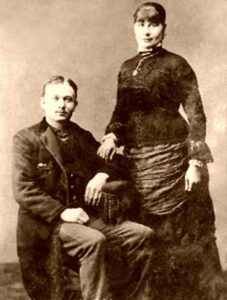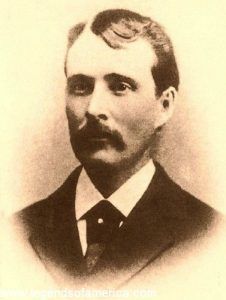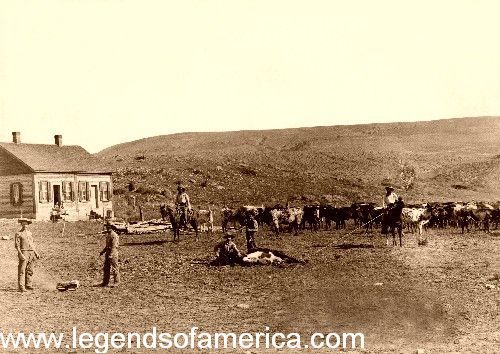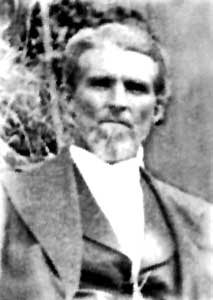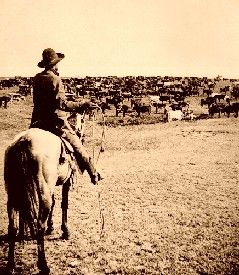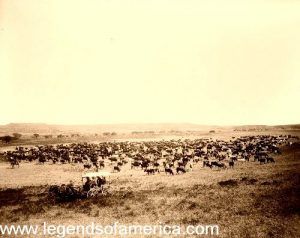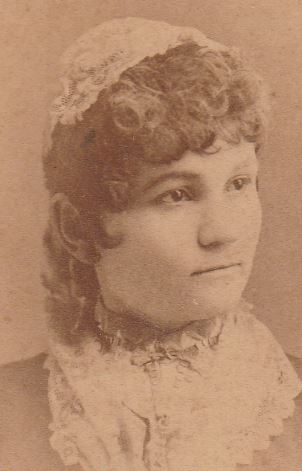
Ellen Watson, aka “Cattle Kate”.
“Witnesses were murdered or disappeared mysteriously or were bought off. The three Cheyenne papers, dominated by incredibly wealthy cattle interests, trumped up the ridiculous stories everyone knows today about Ellen being a dirty whore and rustler, and Jim her accomplice, pimp and murderous paramour.”
— George W. Hufsmith in The Wyoming Lynching of Cattle Kate, 1889
Ellen Watson, dubbed by local newspapers in the late 1880s as “Cattle Kate,” has long been thought of as an outlaw. Watson, along with James Averell, was hanged by vigilantes near the Sweetwater River in Wyoming on July 20, 1889, for the crime of cattle rustling. However, there is a mystery surrounding the hangings, and it appears that their deaths were unjustified, perpetrated by powerful land and cattle owners of the time.
Ellen Liddy Watson was born on July 2, 1861, to Thomas Lewis Watson and Frances Close Watson near Arran Lake, Bruce County, Ontario, Canada. Ella, as she was called, was the oldest of ten children, six of whom were also born in Canada before the family moved to Kansas in 1877. Settling near Lebanon in Smith County, Kansas, Thomas homesteaded the land.
Before long, Ella, as she was called, met a young man by the name of William A Pickell who lived on a neighboring farm. On November 24, 1879, the 18-year-old Ella and the 21-year-old William were married. But within just a few short months, Ella found that her husband was both a heavy drinker and an abusive man. Often, he would verbally abuse her, then escalate the violence to physical blows and striking her with a horsewhip. By January 1883, she could take it no longer and fled to her parents’ home. Later, she moved to Red Cloud, Nebraska, 14 miles north of her parents’ farm, to put even more distance between herself and her estranged husband. On February 14, 1884, she filed for divorce.
Against her parents’ wishes, Ella moved to Denver, Colorado, after filing for divorce. Seeking better opportunities, she lived with a brother for a short time but didn’t stay long. Ella then moved again, first to Cheyenne, Wyoming, then to Rawlins, Wyoming, in late 1885 or early 1886. She found employment at a boarding house called the “Rawlins House” as a cook and domestic for about two years. Watson has often been misidentified as a prostitute because the Rawlins House was erroneously thought to have been a brothel.
On February 24, 1886, she met a handsome young man named James Averell, who was in Rawlins to file a claim on his homestead 60 miles east of Rawlins near the Sweetwater River. Immediately, the two fell for each other and began to court.
James Averell was born on March 20, 1851, to John and Sarah Ann Averell in Renfrew County, Ontario, Canada. The youngest of seven children, his father died shortly after his birth. At the age of 20, Averell, now in the U.S., joined the military and was initially assigned to Fort Douglas, Utah, and later transferred to Fort Fred Steele, Wyoming, 15 miles east of Rawlins. In 1876, he was discharged, but he soon re-enlisted, this time assigned to Fort McKinley, Wyoming, near Buffalo.
In Buffalo, he shot and killed a man by the name of Charlie Johnson, a mean hombre with a reputation for fighting and creating trouble whenever he was drinking. Averell claimed that Johnson had threatened him many times with a knife, and on this particular occasion, James shot the man in the leg and again in the back when the shot to the leg swung the huge man around. James was held in jail at Rawlins for a time while two grand juries were convened, but he was never convicted and was eventually released.
Averell established a homestead on Cherry Creek at the north base of Ferris Mountain and married a young woman by the name of Sophia Jaeger on February 23, 1882. On August 23, 1882, Sophia gave birth to a three-month premature baby boy who lived for only a short time. Soon thereafter, Sophia took sick with what was called “childbed fever,” and she also died. The homestead carried too many sad memories for Averell, so he sold it and established another about 15 miles north, between Horse Creek and the Sweetwater River.
In addition to homesteading, Jim started a general store and tavern on his land. The businesses were successful due to the land’s close proximity to the Oregon and Mormon trails.
After Jim met Ella, he convinced her to move to his homestead with him. He invited her to fix meals for the hungry customers, suggesting she charge 50¢ per meal and keep the money. He also suggested that she might be able to homestead her own piece of land, a tract adjacent to his own. Ella agreed and soon lived in the Sweetwater Valley.
Ella’s divorce was finally official in March 1886, and just a few short months later, James and Ella applied for a marriage license in Lander, Wyoming. It is unclear if the couple ever actually married, as the completed application was never returned. Some said the two planned to get married after Ella proved her own homestead (only one claim per family was allowed).
On June 29, 1886, Jim was appointed the postmaster of his newly created community and made the Justice of the Peace. Living with Averell at his home, Ella worked for him in the general store and cafe. Ella saved her money and eventually purchased some cattle with her earnings. Settling on the adjacent land in August 1886, she built a two-room log house and began digging irrigation ditches.
Ella tried to get a brand registered for her cattle but was refused due to what was known as the Maverick Law, passed in 1884. This law provided that unbranded calves found on the open range could not be legally taken off the range by just anyone. They were to be branded on the neck with an “M”. They became the exclusive property of the Wyoming Stock Growers Association, an influential group of men that controlled the cattle industry in Wyoming at the time. The Wyoming Stock Growers Association was also appointed as the official law enforcement agency for the Wyoming cattle industry.
The law also provided that those young calves be auctioned off to the highest bidder only by appointed representatives of the association and that the proceeds went to the association to cover the costs of policing the range. In 1886, a provision was added to the law that no one could brand calves except those receiving registered brands from the state. Further, small cattle ranchers or homesteaders were not permitted to bid on mavericks unless they had a registered brand.
In essence, the law locked out the small ranchers and homesteaders from competing with the large Stock Growers Association. It also put their calves at risk if they strayed too far from their property. When this occurred, the association would round them up and sell them.
At this same time, the big cattle owners of the area began to file claims to much of the area’s land illegally. By placing movable cabins on their claims, they could state that the property had been “improved,” a requirement of the Homestead Act.
After the claim was filed, they would place logs under the cabins and roll them to another homestead property, repeating the process over and over. Jim Averell, as a Justice of the Peace, began to write letters to the newspaper at Casper, Wyoming, which infuriated the large cattlemen.

Cheyenne, Wyoming, 1868.
On March 23, 1888, Ella filed her official homestead claim with the Land Office in Cheyenne. Between both homesteads, James and Ella now owned more than 320 acres of land. Ella continued to improve her property by building corrals for the livestock and fencing much of the property.
Finally, with a new governor, the 1888 Legislature repealed the Maverick Law under heavy pressure from the small cattle and landowners. In the fall of that year, Ella bought 28 head of cattle from a man who was driving them from Nebraska to the Salt Lake basin. But by the time he had arrived in the area, the cattle were footsore and in poor condition.
On December 3, 1888, she applied for the WT brand through the Carbon County Brand Committee in Rawlings, but they rejected her application.
On March 16, 1889, she bought a brand from a nearby rancher. Since it was already registered with the Brand Committee, this time, her application was accepted.
Early in 1889, Ella unofficially adopted an eleven-year-old boy by the name of Gene Crowder. Crowder’s father, John M. Crowder, was a widower, a drifter, and a heavy drinker. Crowder had several children but was unable to take care of young Gene, so Ella took him in. Gene helped her with her growing ranch along with another fourteen-year-old boy named John L. DeCorey, whom Ellen had hired to work for her. In April, Ralph Coe, Jim’s 20-year-old nephew from Wisconsin, joined the ranch.
Another friend who helped them was a neighbor named B. Frank Buchanan, who helped mend fences and assisted Ellen with branding the cattle. By the middle of July 1889, Ella had 41 head of cattle branded with her new LU brand.
Albert John Bothwell, a wealthy cattleman and member of the Stock Association, lived about a mile from Jim and Ellen. Prior to Ellen homesteading her piece of land, Bothwell had used the property, as well as other large sections of open range, as pastureland for his cattle. In fact, Bothwell was in the habit of running his cattle through the entire Sweetwater Valley, spreading out some twenty miles.
Though he didn’t own all of the land, he acted as though he did. Bothwell was one of the most dreaded cattlemen in the area. His main focus was getting the homesteaders off of “his” land. He was furious when Jim and Ellen homesteaded the property that he considered his best pastureland. Approaching Ellen several times, he tried to buy her property, but she refused him.
Jim Averell had given Bothwell a right-of-way through his property so that Bothwell could irrigate his pastureland. Still, on a few occasions, Jim had threatened to cut off his water supply, which further infuriated the cattleman. Bothwell was determined to run Jim and Ellen off their property.
When Jim wrote the letters to the Casper Newspaper, Bothwell sent his cowhands to harass the couple. The men would often watch the couple to make sure they didn’t do anything out of the ordinary. At other times, the cowhands placed skulls and crossbones on their doorways. Bothwell also had the men fence in areas of land that did not belong to him.
On July 20, 1889, a stock detective named George Henderson rode through Ellen’s pasture in the early morning, finding the cattle with their fresh LU brands. Henderson, a member of the Stock Association, quickly suggested that Ellen might be illegally branding cattle. Though Bothwell no doubt knew that Ellen had had the cattle for almost a year, he saw this as his long-sought-after opportunity to rid himself of Jim Averell and Ellen Watson.
Bothwell sent for other cattlemen in the immediate area to meet him for an urgent meeting. Who knows what he actually told them, but by the time the meeting was over, the cattlemen were convinced that Jim and Ellen had stolen the newly branded cattle. One of the men rode over to Ellen’s pasture to verify the new brands, returning to tell the others about it. The men then decided to take matters into their own hands. Several of the cattlemen wanted no part of the vigilante’s plans and left, but six cattlemen remained. These six ranchers included Bothwell, the ringleader, M. Earnest McLean, Robert “Captain” M. Galbraith, John Henry Durbin, Robert Conner, and Tom Sun.
After the meeting, they all decided to ride over to Ellen’s homestead and see the evidence for themselves. Arriving in the early afternoon, they found the newly branded cattle, and their suspicions were confirmed. John Durbin lost his temper and began tearing down the barbed wire fence and driving the cattle out. Gene Crowder, the boy whom Ellen had unofficially adopted, watched as McLain and Conners detained Ella outside, keeping her from returning to her house. Forcing her into the wagon, they explained to her that they were going to Rawlins. Then they started toward Jim Averell’s place. Crowder tried to go around them, but Bothwell detained him, and he was forced to stay with Durbin.
Jim, who was starting to Casper, was just inside the gate when the men approached. Stating they had a warrant for his arrest, Jim demanded to see the document, at which time Durbin and Bothwell drew their guns. Jim was made to unhitch his team and climb in the wagon along with Ella, and then the group began to travel north. Crowder was allowed to leave and made tracks back to Jim’s house, where he explained to the others what was going on. Frank Buchanan quickly got on his horse and began to follow the vigilantes.
Buchanan followed the group for about two miles as they traveled up the east side of Averell Mountain, then headed southwest across the sagebrush toward Sweetwater River and Independence Rock. Finally, the vigilantes stopped at a gulch on the south side of the river. As Buchanan watched, Bothwell tied a rope to a tree, wrapping the other end around Jim’s neck, while McLain was attempting to put a rope around Ella’s dodging neck. At the sight of this, Buchanan opened fire on the vigilantes, but when the group returned fire, he fled for his life. Returning to the ranch, he told Gene Crowder, John L. DeCorey, and Ralph Coe about the hangings.
Though an investigation into the hangings began almost immediately, the bodies were left to hang in the July heat for 2 ½ days. A reporter, who was the first to talk to members of the posse, described it as thus:
“Hanging from the limb of a stunted pine growing on the summit of a cliff fronting the Sweetwater River were the bodies of James Averell and Ella Watson. Side by side, they swing, their arms touching each other, their tongues protruding, and their faces swollen and discolored almost beyond recognition. Common cowboy lariats had been used, and both had died by strangulation; neither had fallen over two feet. Judging from signs too plain to be mistaken, a desperate struggle had taken place on the cliff, and both man and woman had fought for their lives until the last.”
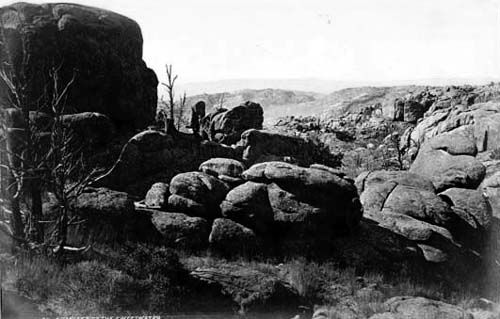
Sweetwater River Rocks.
Their bodies were cut down and taken to Averell’s roadhouse, where Justice of the Peace B.F. Emery, a Casper attorney, solemnly swore in those present and held an official coroner’s inquest over their bodies. Further, he made the resulting verdict to the effect that the deceased met their death at the hands of John Durbin, Tom Sun, A.J. Bothwell, Robert Conner, Robert Galbraith, and a man named Earnest McLean.
Their remains were then returned to Jim’s Ranch about 3:00 a.m. on July 23, 1889, by E. Joseph Healy, who was a juror on the inquest panel. Ralph Coe, along with another man by the name of Jess Lockwood, buried the pair on Jim’s Ranch. At the time of their deaths, Jim was 38 and Ella was 27.
Deputy Philip Watson arrested the six vigilantes, took them to Carbon County, and turned them over to Sheriff Frank Hadsell. The following day, on July 26, 1889, the Cheyenne Daily Leader reported:
“A Rawlins telegram says that all the men were arrested by Sheriff Hadsell of Carbon County and given a preliminary hearing yesterday afternoon. Bail was fixed at a $5,000 bond. Each lyncher was allowed to post each other’s bond.”
The Grand Jury was convened for August 25, 1889, but before the witnesses could testify, they began to die or disappear mysteriously. Shortly after the hangings, Gene Crowder disappeared, never to be seen again. Some said that his father heard of the affair and took him away to protect him from the powerful members of the Stock Association. John DeCorey, the boy who worked for Ellen, allegedly went to Steamboat Springs, Colorado, but was never summoned for the hearing.
Then Frank Buchanan also disappeared before the hearing. He was reportedly last seen in protective custody in Cheyenne, Wyoming. However, a year or so later, W.R. Hunt, a reporter working for the Chicago Inter-Ocean, reported seeing him. A notebook by Hunt, found years later in the attic of a Kansas City home, tells where Buchanan wandered all over the country for the next year or two, hiding from the powerful cattlemen and fearing for his life.
Ralph Cole, Jim Averell’s nephew, mysteriously died on the very day of the scheduled hearing, possibly from poisoning.
With no witnesses to testify, all charges were dropped against the six cattlemen. No attempts were ever made to investigate the death of Ralph Cole, nor the three disappearances of the primary witnesses against the six ranchers.
Rumors abounded that Bothwell had some of his cowboys ride to the different homesteaders and small ranchers, telling them that if they testified against the ranchers, they would be burned out or, worse, end up like Jim and Ella.
A neighbor by the name of Tex would later say that the whole affair grew out of land troubles. Averell had contested the land Conner was trying to hold, had made Durbin some trouble on a final proof, and kept Bothwell from fencing the whole Sweetwater Valley. He also stated that Ella Watson had a small bunch of cattle and had come by them honestly, freshly branded, because she had only recently recorded her brand. Nevertheless, Tex did not come forward for the hearing.
There were others too, who did not come forward – two from the local newspaper, the Sweetwater Chief. Having been alerted by two unnamed cattlemen, H.B. Fetz, the newspaper editor, and his assistant, J.N. Speer, witnessed the abduction with field glasses from the rooftop of the newspaper building. Watching the angry procession file very near, they first saw the procession as they made their way to examine Ellen’s calves, and again later when they had abducted Ella and Jim. Neither volunteered to give testimony at the grand jury hearings that were later held in Rawlings.
Another witness to the abduction was a man by the name of Dan Fitger. While Fitger was plowing a hay meadow, he could clearly see the lynching party down in the river bottom, with Buchanan following far behind. Fitger never came forward at the hearings, but years later, he told this story to his family.
After their deaths, George W. Durant was appointed administrator of their estates. The land, which was not yet legally theirs, would have to be turned back over to the government. Ella’s property, with the exception of a few personal items, was sold at auction for $322.75. Jim’s property netted $657.90. Durant also filed a lawsuit against A.J. Bothwell and John Durbin for the return of 41 head of cattle, but the lawsuit was never ruled upon.
In the same year as the lynching, both Albert Bothwell and Tom Sun were made members of the Wyoming Stockgrowers Association Executive Committee, and Captain Galbraith was elected to the legislature. John Durbin served one year on the committee with his two neighbors in 1894.
A few years after Ella’s death, Bothwell finally acquired both Watson’s and Averell’s homesteads and moved his house onto what had been Ella’s homestead claim.
Much of the confusion surrounding this entire affair, as well as the apparently inaccurate information about the victims, resulted from the abundance of bad press that “Cattle Kate” and Jim Averell received from the Wyoming newspapers following their deaths. It appears that the press was also in the “pockets” of the powerful Stock Growers Association. The three Cheyenne papers trumped up the stories that everyone knows today about Ellen being a whore and rustler, and Jim her accomplice, pimp and murderous paramour.
The pair’s death was just one of the many events that effectively started the infamous Johnson County War in Wyoming in 1892. The Johnson County War began when a small group of ranchers in Johnson County formed the upstart Northern Wyoming Farmers and Stock Growers Association in direct opposition to the powerful Wyoming Stock Growers Association.
©Kathy Alexander/Legends of America, updated May 2025.
Also See:
James Averell – Unjustly Hanged
Nate Champion – Killed in the Johnson County War
See Sources.

